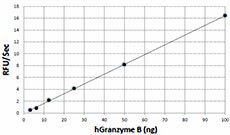- Regulatory Status
- RUO
- Other Names
- Granzyme 2, cytotoxic T-lymphocyte-associated serine esterase 1, GZMB, CCP1, Asp-ase

-

The activity of recombinant human Granzyme B is determined by its ability to cleave a colorimetric peptide substrate, t-Butyloxycaronyl-Ala-Ala-Asp-ThioBenzyl ester (Boc-AAD-SBzl), in the presence of 5,5'Dithio-bis (2-nitrobenzoic acid) (DTNB), with an activity >1500 pmol/min/µg.
| Cat # | Size | Price | Quantity Check Availability | ||
|---|---|---|---|---|---|
| 554902 | 10 µg | $223.00 | |||
| 554904 | 25 µg | $440.00 | |||
Granzyme B is a serine protease expressed by cytotoxic T cells (CTL) and NK cells. Its main function is to induce cell death to eliminate harmful targets such as allogeneic, virally infected, and tumorous cells. This is evident by the fact that CTLs from mice with inhibited granzyme B production exhibit a profound defect in inducing rapid DNA fragmentation and apoptosis in target cells. Following receptor-mediated conjugate formation between CTL or NK and their target cell, granzyme B enters the target via endocytosis, and subsequently activates multiple protein substrates to induce apoptosis. Most circulating CD56+ CD8- NK cells, and approximately half of circulating CD8+ T cells, coexpress both granzyme A and B. In contrast, few circulating CD4+ T cells express granzymes A or B. Activation of CD8+ and CD4+ T lymphocytes induce substantial expression of granzyme B, but not granzyme A. Besides CTL and NK, evidence has shown that the distribution of human granzyme B has a broader spectrum of cells, including CD34+ hematopoietic progenitor cells, keratinocytes, basophils, mast cells, plasmacytoid dendritic cells, and B cells. Although its role in cytotoxic lymphocyte-mediated apoptosis is well established, granzyme B can also degrade extracellular matrix proteins and alter inflammation if present in the extracellular milieu. These findings suggest that granzyme B can function as an activation molecule with potentially important immunoregulatory functions. In addition, it was shown that expression of granzyme B is elevated in acute coronary syndrome and acute myocardia infarction, indicating that granzyme B could be a factor involved in cardiovascular diseases.
Product Details
- Source
- Human Granzyme B, amino acids (Gly19-Tyr249) (Accession# NP_004122.2), was expressed with a C-terminal 10 His tag and a linker sequence in 293E cell line.
- Molecular Mass
- This 244 amino acid recombinant protein has a predicted molecular mass of approximately 27.5 kD. The protein migrates at about 37 kD in DTT-reducing conditions and about 37 kD in non-reducing conditions by SDS-PAGE.The predicted N-terminal amino acid is Gly.
- Purity
- >95%, as determined by Coomassie stained SDS-PAGE.
- Formulation
- 0.22 µm filtered protein solution is in 20 mM Tris, 150 mM NaCl, pH 7.5.
- Endotoxin Level
- Less than 1.0 EU per µg of protein as determine by the LAL method.
- Concentration
- 10 - 100 µg sizes are bottled at 200 µg/mL.
- Storage & Handling
- Unopened vial can be stored at -70°C for six months. For maximum results, quick spin vial prior to opening. Avoid repeated freeze/thaw cycles.
- Activity
- Human Granzyme B activated by mouse Cathepsin C is able to cleave the peptide substrate t-Butyloxycaronyl-Ala-Ala-Asp-ThioBenzyl ester (Boc-AAD-SBzl), in the presence of 5,5'Dithio-bis (2-nitrobenzoic acid) (DTNB), with an activity >1500 pmol/min/µg. This recombinant protein is in its inactive form and needs to be activated prior to use in bioassays. Please contact technical support for a detailed activation protocol.
- Application
-
Bioassay
- Application Notes
-
This protein is in the latent form and needs to be activated for bioassay.
BioLegend carrier-free recombinant proteins provided in liquid format are shipped on blue-ice. Our comparison testing data indicates that when handled and stored as recommended, the liquid format has equal or better stability and shelf-life compared to commercially available lyophilized proteins after reconstitution. Our liquid proteins are verified in-house to maintain activity after shipping on blue ice and are backed by our 100% satisfaction guarantee. If you have any concerns, contact us at tech@biolegend.com.
Antigen Details
- Structure
- Monomer
- Distribution
-
Cytotoxic T cells, NK cells, and neutrophils.
- Function
- Granzyme B is able to induce target cell apoptosis by activating caspase independent pathways. Granzyme B is induced in CD8+ T lymphocytes with ConA / IL-2 and CD4+ T lymphocytes with anti CD3/CD28 or CD3/CD46.
- Interaction
- Targets of CTL and NK cells.
- Bioactivity
- Human Granzyme B activated by mouse Cathepsin C is able to cleave the peptide substrate t-Butyloxycaronyl-Ala-Ala-Asp-ThioBenzyl ester (Boc-AAD-SBzl), in the presence of 5,5' Dithio-bis (2-nitrobenzoic acid) (DTNB).
- Biology Area
- Cell Biology, Immunology, Innate Immunity, Neuroscience
- Molecular Family
- Proteases, Enzymes and Regulators
- Antigen References
-
1. Edwards KM, et al. 1999. J. Biol. Chem. 274:30468.
2. Grossman WJ, et al. 2004. Blood. 104:2840.
3. Heusel JW, et al. 1994. Cell. 76:977.
4. Schmid J and Weissman C. 1987. J. Immunol. 139:250.
5. Trapani JA, et al. 1988. Proc. Natl. Acad. Sci. USA 85:6924.
6. Heibert PR, and Granville DJ. 2012. Trends. Mol. Med. 18:732.
7. Saito Y, et al. 2011. J. Cardiol. 57:141. - Gene ID
- 3002 View all products for this Gene ID
- UniProt
- View information about Granzyme B on UniProt.org
